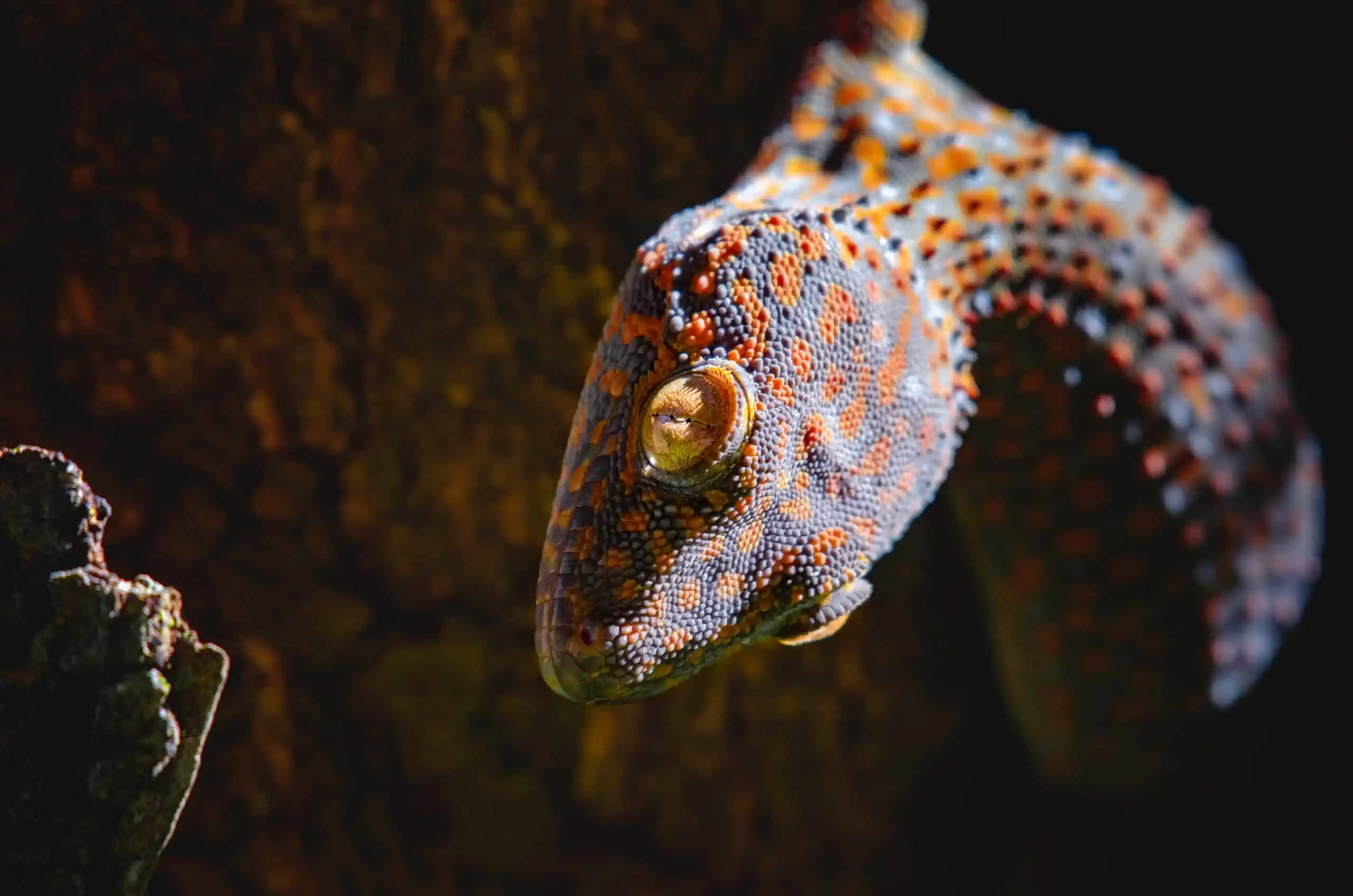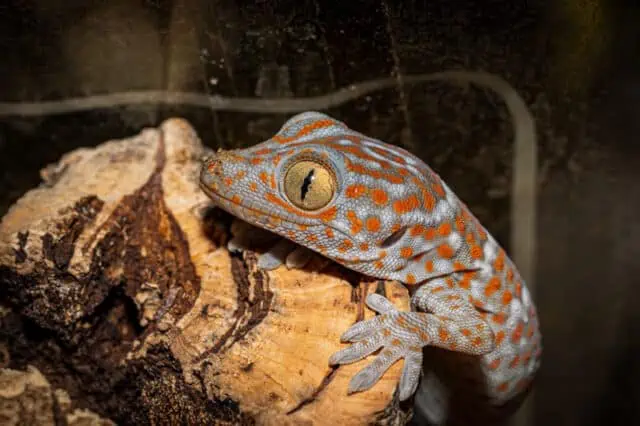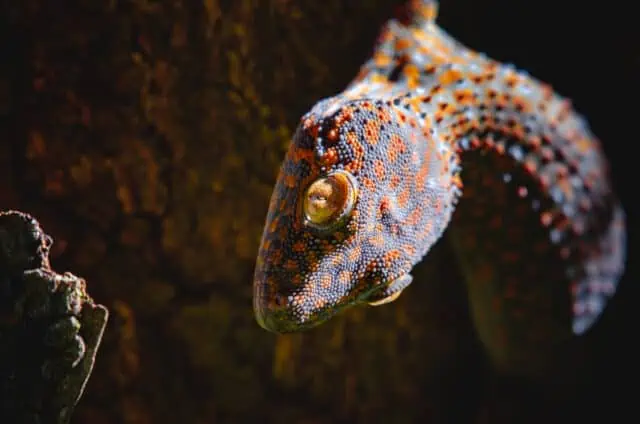Hey there, fellow reptile enthusiasts! If you’re fascinated by the diverse and intriguing world of geckos, then you’ve probably come across the Tokay Gecko (Gekko gecko). Known for their striking appearance and unique behaviors, these geckos can be an amazing addition to your reptile family. But do you understand what their vocalizations, movements, and body language actually mean? No need to worry if you’re scratching your head – that’s exactly what we’re here to delve into today!
Unpacking the behavior of these exotic creatures not only amps up the wonder of having them around but also plays a crucial role in their care and management. For breeders, a firm understanding of these behaviors is fundamental to fostering a healthy breeding environment. Researchers, on the other hand, can gain valuable insights into the species’ biology and ecology. And for pet owners? Well, comprehending what your Tokay Gecko is trying to say can significantly strengthen the bond you share with your scaly friend. So, let’s jump right in and begin our journey to decode the world of Tokay Gecko behavior!
Understanding Tokay Gecko Vocalizations
To the untrained ear, the sounds made by a Tokay Gecko might seem like random noise. But there’s actually a lot more to these vocalizations than you might think. These geckos are among the most vocal of their kind, with a variety of different calls and sounds that convey different messages.
First, let’s talk about the Tokay’s signature call. Have you ever heard a loud, almost two-note “TO-kay” sound echoing around your house in the middle of the night? Well, that’s where this gecko got its name! The “TO-kay” call is a mating call, typically produced by males to attract females. Sometimes, you may hear it followed by a series of softer, chuckling notes. This variation of the call is also associated with mating, showing that the male is extremely interested and ready to mate.
But mating calls are not the only sounds Tokay Geckos make. A distinct, aggressive hiss is another common vocalization, often used when they feel threatened or cornered. They might also bark or growl in such situations. On the other hand, quieter chirps are usually a sign of curiosity or mild alertness.
It’s important to note the context in which these vocalizations occur, as the same sound can mean different things in different situations. For instance, a series of rapid clicks may be a sign of contentment when a gecko is well-fed and comfortable, but it might also be a warning if the gecko feels threatened.
Also, pay attention to the frequency and intensity of the vocalizations. An increase in frequency or a sudden change in the type of sounds being produced could indicate stress, fear, or even illness. Understanding these nuances in Tokay Gecko vocalizations can be a powerful tool in ensuring the health and happiness of your scaly companion.
Remember, these sounds are a significant part of your gecko’s communication arsenal. Learning to identify and respond to them appropriately can greatly enhance your interactions with your Tokay Gecko, whether you’re a breeder, a researcher, or a loving pet owner. So, lend an ear to your gecko’s calls – they have a lot to say!
Deciphering Tokay Gecko Movement
When it comes to understanding our Tokay friends, it’s not all about sound – their movements are equally expressive. Observing how a Tokay Gecko moves can provide valuable insights into its feelings, health, and overall well-being.
A healthy, content Tokay Gecko typically displays smooth and agile movement. These guys are arboreal creatures, which means they love to climb. When they’re happy and comfortable, you’ll often see them effortlessly gliding up and down the walls of their enclosure, exploring their surroundings with keen interest. Their tails play a significant role in their movement, acting as a fifth limb to provide extra grip during climbing.
Now, remember how I mentioned environmental factors? Changes in temperature, humidity, or light can have a significant impact on your gecko’s movements. For instance, during the cooler hours of the night, your gecko is likely to be more active, as these nocturnal creatures prefer to hunt and explore when it’s dark. During the day, you’ll often find them tucked away in a warm, secure spot, resting up for their next nighttime adventure.
But what if your Tokay’s movement seems off? Abnormalities like sluggishness, lack of coordination, frequent falls, or even a refusal to climb might be a sign that something’s not right. These could point to health issues, stress, or inappropriate living conditions. If you notice any such signs, it might be a good idea to consult a vet or reassess your gecko’s habitat to ensure it’s meeting all their needs.
Understanding these movement patterns and their implications can be an invaluable tool in maintaining your gecko’s health and happiness. It’s all about being observant and responsive to changes. After all, these little guys might not be able to tell us what’s wrong in words, but their actions often speak volumes.
Interpreting Tokay Gecko Body Language
Isn’t it amazing how much you can understand about your gecko’s feelings and desires just by observing their behavior? And we’re not done yet! Now let’s delve into the realm of body language, another crucial component in deciphering the messages your Tokay Gecko is trying to convey.
First, let’s talk about their eyes. Tokay Geckos have incredible vision, and they use their eyes to communicate a variety of emotions and intentions. A relaxed gecko will often have half-closed eyes, a sign that they are at ease in their surroundings. But if their eyes are widely open, it could mean they are alert and curious or, in some cases, feeling threatened.
Next up, the tail. As mentioned before, Tokay Geckos use their tails as a form of communication. A slow, deliberate tail wag, often combined with a hiss or a bark, can be a warning to back off. In contrast, a rapidly twitching tail is usually a sign of excitement or anticipation, especially when food is involved.
Posture is another critical aspect of body language. When a Tokay Gecko feels threatened or wants to appear larger to a potential threat, it will flatten its body against the surface, open its mouth wide, and vocalize loudly. This aggressive display is often enough to deter predators or any unwelcome guests.
One of the most poignant signs to look for is color change. While not as famous as their chameleon cousins, Tokay Geckos can also adjust their skin color based on their mood, health, and environmental factors. A healthy Tokay should display bright, vibrant colors. However, a dull or uneven coloration might indicate stress, illness, or suboptimal habitat conditions.
By recognizing these elements of body language, you can better understand your gecko’s needs and emotions, allowing you to respond more effectively. Whether it’s adjusting their habitat, introducing a new diet, or just giving them some space, your informed actions can make a world of difference in the life of your scaly friend.
The Interplay between Vocalizations, Movement, and Body Language
So, we’ve covered vocalizations, movements, and body language separately. But in reality, these elements of Tokay Gecko behavior don’t exist in isolation. They often weave together to create a symphony of communication, each aspect adding depth and context to the others. Understanding this interplay can give us a far more nuanced view of our gecko’s behavior.
Let’s consider an example. Suppose your gecko is on the floor of its enclosure, its body flattened, its mouth open wide, and it’s making a loud hissing sound. Here, the body language and vocalization work together to convey a clear message: “I feel threatened, back off.” Now, if the gecko starts moving towards the perceived threat with its tail wagging slowly, that’s an escalation, a clear warning that it’s ready to defend itself if necessary.
Contrast this with a gecko that’s chirping softly, its eyes half-closed and its tail gently twitching as it navigates its enclosure. This combination of sounds, movements, and body language generally indicates a gecko that’s comfortable and content in its environment.
Or think about a male gecko during the mating season. He’ll combine the “TO-kay” call with specific movements like head bobbing or tail twitching to attract a mate.
Recognizing these combinations can often provide more accurate insights into your gecko’s state of mind than any single element could. It also allows you to respond more appropriately to their needs, whether that means providing medical care, adjusting their habitat, or simply giving them some space.
So next time you’re observing your Tokay Gecko, try to look at the bigger picture. Listen to their sounds, watch their movements, and pay attention to their body language. Understand how these elements interplay, and you’ll uncover a whole new depth to your understanding of these fascinating creatures.
Practical Implications for Tokay Gecko Owners
Now that you’re becoming quite the expert on Tokay Gecko behavior, you might be wondering, “How does all this apply to me as a gecko owner?” Well, understanding your gecko’s behavior can greatly enhance the quality of life you provide for your pet, and consequently, deepen the bond you share.
First and foremost, it can aid in identifying health issues early. Changes in behavior, such as shifts in vocalization patterns, abnormal movements, or changes in body language, can often indicate underlying health problems. Recognizing these signs can prompt timely vet visits, improving your pet’s chances of recovery.
It can also help in managing your gecko’s habitat more effectively. For instance, if you notice your gecko being more active during certain times or reacting positively to specific environmental changes, you can adjust their living conditions accordingly.
Additionally, it can guide you in handling your gecko. Knowing when your gecko is feeling threatened can prevent mishandling, reducing stress for both you and your pet. For example, if your gecko is hissing and has a flattened body, it might be best to give them some space.
Understanding your gecko’s behavior can also enhance your interaction with them. Recognizing signs of curiosity or contentment can provide opportunities for positive engagement, such as introducing new toys or treats.
Above all, being in tune with your Tokay Gecko’s behavior can foster a more profound and meaningful connection with your pet. It allows you to understand their needs, desires, and fears, paving the way for a relationship based on mutual trust and respect.
Conclusion
Well, folks, we’ve covered quite a lot today, haven’t we? We’ve explored the complex world of Tokay Gecko behavior, from their distinctive vocalizations to their expressive body language and fascinating movement patterns. We’ve discussed how these elements interact to provide a richer understanding of what these intriguing creatures are communicating. And we’ve looked at some practical implications of this knowledge for Tokay Gecko owners.
Remember, understanding these behaviors is more than just an exciting insight into the lives of these amazing creatures. It’s a powerful tool that can significantly enhance your gecko care practices, whether you’re a breeder, a researcher, or a pet owner. By observing and interpreting these behaviors, you can cater better to your gecko’s needs, fostering a healthier and happier environment for them.
So, the next time you’re watching your Tokay Gecko, remember what you’ve learned here. Pay attention to their sounds, movements, and body language. Listen to what they’re trying to say. And most importantly, respond with empathy and understanding. Trust me, your Tokay Gecko will thank you for it!
Frequently Asked Questions (FAQs)
Why is my Tokay Gecko hissing at me?
Hissing is a common defensive behavior in Tokay Geckos. If your gecko is hissing at you, it’s likely that they’re feeling threatened or scared. This could be due to a variety of factors, from sudden movements to improper handling or an unfamiliar environment. Try to minimize these stressors and give your gecko some space to calm down.
Why is my Tokay Gecko not making any sounds?
While Tokay Geckos are generally quite vocal, there can be periods when they’re quieter. This could simply be due to their natural daily rhythms (remember, they’re more active at night). However, if your gecko has stopped vocalizing completely, it might be a sign of stress or illness. It’s a good idea to consult a vet if you’re concerned.
Why is my Tokay Gecko’s color fading?
Color changes in Tokay Geckos can be due to a range of factors, including changes in light, temperature, or humidity, stress, illness, or age. If your gecko’s color is fading and you’re unable to identify a clear environmental cause, it’s worth seeking veterinary advice.
Why is my Tokay Gecko pacing and scratching at the glass of its enclosure?
This behavior, known as ‘glass surfing’, can be a sign of stress or discomfort. Your gecko might be feeling cramped, too hot, too cold, or simply bored. Check the habitat conditions (temperature, humidity, space, etc.) and make sure they are in line with your gecko’s needs.
Can I handle my Tokay Gecko regularly?
While some geckos can get used to handling, Tokay Geckos are known for their skittish nature. They tend to be more comfortable observing from a distance. Overhandling can cause stress, so it’s best to limit direct handling and always be gentle and slow when you do need to handle them. Always watch for signs of distress and give your gecko space when needed.
What does it mean when my Tokay Gecko’s tail is twitching?
Tail twitching in Tokay Geckos can mean several things, depending on the context. It can be a sign of excitement or anticipation, often seen when food is about to be served. However, it can also be a defensive signal, warning potential threats to stay away. Be sure to consider the situation and other behaviors your gecko is exhibiting to understand what the tail twitching means.







